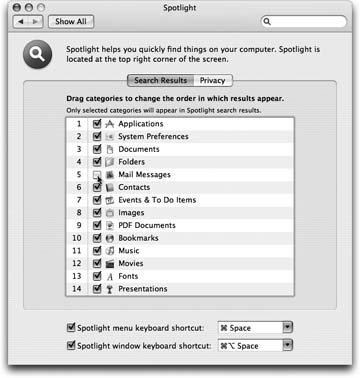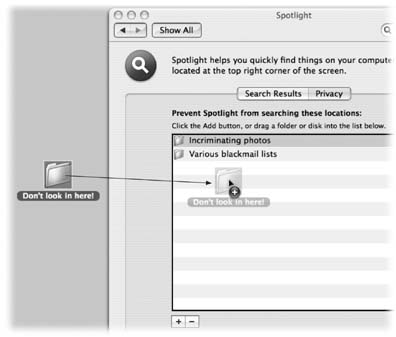| You've just read about how Spotlight works fresh out of the box. But you can tailor its behavior, both for security reasons and to fit it to the kinds of work you do. Here are three ways to open the Spotlight preferences center: -
Choose "Spotlight preferences" at the bottom of the Spotlight menu (that is, just after you've performed a search). -
Use Spotlight itself. Hit  -Space, type spotl , press -Space, type spotl , press  -Enter. -Enter. -
Open System Preferences. Click Spotlight. In any case, you wind up face-to-face with the dialog box shown in Figure 3-5. You can tweak Spotlight in three ways here, all very useful.  | Figure 3-5. Here's where you can specify what categories of icons you want Spotlight to search, which order you want them listed in the Spotlight menu, and what keystroke you want to use for highlighting the Spotlight bar. | |
-
Turn off categories . The list of checkboxes identifies all the kinds of things that Spotlight tracks. If you find that Spotlight uses up valuable menu space listing, say, Web bookmarks or fontsstuff you don't need to find very oftenturn off their checkboxes. Now the Spotlight menu's precious 20 slots will be allotted to icon types you care more about. -
Prioritize the categories . This dialog box also lets you change the order of the category results; just drag an individual list item up or down to change where it appears in the Spotlight menu. The factory setting is for Applications to appear first in the menu. That makes a lot of sense if you use Spotlight as a quick program launcher (which is a great idea, by the way). But if you're a party planner, and you spend all day on the phone, and the most important Spotlight function for you is its ability to look up someone in your address book, then drag Contacts to the top of the list. You'll have fewer arrow-key presses to perform once the results menu appears. -
Change the keystroke . Ordinarily, pressing  -Space highlights the Spotlight search box in your menu bar, and Option- -Space highlights the Spotlight search box in your menu bar, and Option-  -Space opens the Spotlight window described above. If these keystrokes clash with some other key assignment in your software, though, you can reassign them to almost any other keystroke you like. (For starters, this is also the time-honored Mac OS X keystroke for switching keyboard layouts, if you're an international kind of person.) -Space opens the Spotlight window described above. If these keystrokes clash with some other key assignment in your software, though, you can reassign them to almost any other keystroke you like. (For starters, this is also the time-honored Mac OS X keystroke for switching keyboard layouts, if you're an international kind of person.) Most people notice only the pop-up menu that lets you select one of your F-keys (the function keys at the top of your keyboard). But you can also click inside the white box that lists the keystroke and then press any key combinationControl-S, for exampleto choose something different. Whatever keystroke you choose must include at least one of the modifier keys Option, Control, or  , or one of the F-keys (such as F4). , or one of the F-keys (such as F4).
Note: Apple assumes no responsibility for your choosing a keystroke that messes up some other function on your Mac.  -S, for example, would not be a good choice.On the other hand, if you choose a Spotlight keystroke that Mac OS X uses for some other function (like Shift- -S, for example, would not be a good choice.On the other hand, if you choose a Spotlight keystroke that Mac OS X uses for some other function (like Shift-  -3), a little yellow alert icon appears in the Spotlight pane. This icon is actually a button ; clicking it brings you to the Keyboard and Mouse pane, where you see exactly which keystroke is in dispute, and change it. -3), a little yellow alert icon appears in the Spotlight pane. This icon is actually a button ; clicking it brings you to the Keyboard and Mouse pane, where you see exactly which keystroke is in dispute, and change it.
3.3.1. Privacy Settings Ordinarily, Spotlight doesn't consider any corner of your hard drive off-limits. It looks for matches wherever it can except in other people's Home folders. (That is, you can't search through other people's stuff ). But even within your own Mac world, you can hide certain folders from Spotlight searches. Maybe you have privacy concernsfor example, you don't want your spouse Spotlighting your stuff while you're away from your desk. Maybe you just want to create more focused Spotlight searches, removing a lot of old, extraneous junk from its database. Either way, the steps are simple. Open the Spotlight panel of System Preferences, as described above. Click the Privacy tab. Figure 3-6 explains the remaining steps.
Tip: When you mark a disk or folder as non-searchable, Spotlight actually deletes its entire index (its invisible card-catalog filing system) from that disk. If Spotlight ever seems to be acting wackily, you can use this function to make it rebuild its own index file on the problem disk. Just drag the disk into the Privacy list and then remove it again! Spotlight will delete, and then rebuild, the index for that disk.(Don't forget the part about "remove it again," though. If you add a disk to the Privacy list, Spotlight will no longer be able to find anything on it, even if you can see it right in front of you.)
 | Figure 3-6. You can add disks, partitions, or folders to the list of nonsearchable items just by dragging them from the desktop into this window. Or, if the private items aren't visible at the moment, you can click the + button, navigate your hard drive, select the item, and click Choose. To remove something from this list, click it and then press the Delete key or click the - button. | |
Once you've built up the list of private disks and folders, close System Preferences. Spotlight will pretend they don't even exist. |

